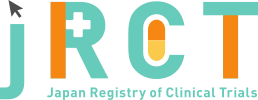臨床研究等提出・公開システム
|
July. 12, 2023 |
|
|
Oct. 08, 2025 |
|
|
jRCT2071230040 |
AZD3152 is being evaluated for administration to prevent COVID-19. This Phase I study will gather important information on the safety and tolerability of AZD3152 as well as relevant data on the PK, PD (as the neutralising responses against SARS-CoV-2) profile and the generation of ADA to AZD3152. |
|
A Phase I Double-blind, Placebo-controlled Study to Evaluate the Safety, Tolerability, Pharmacokinetics and Pharmacodynamics of AZD3152 in Healthy Japanese Adults |
|
Dec. 05, 2024 |
|
24 |
|
Across all participants who received AZD3152 (AZD3152 Total), the mean (SD) age of study participants was 39.0 (13.6) years (range: 20 to 55 years). Ten (55.6%) participants were male, and 8 (44.4%) participants were female. The mean (SD) BMI of the participants was 22.35 (2.73) kg/m2. In the pooled placebo group, the mean (SD) age of study participants was 44.8 (6.6) years (range: 35 to 53 years). Two (33.3%) participants were male, and 4 (66.7%) participants were female. The mean (SD) BMI of the participants was 20.89 (0.74) kg/m2. All participants were Asian and not Hispanic or Latino. |
|
Target Population and Sample Size Approximately 24 healthy Japanese participants were planned to be randomised to AZD3152 or placebo across 3 cohorts (6:2 within each cohort). No formal sample size calculations were performed because all analyses are descriptive in nature and no hypotheses are being tested statistically. However, the sample size is considered sufficient for an early assessment of safety, tolerability, immunogenicity, PK, and PD. Investigational Product and Comparator: Dosage, Mode of Administration Participants received either AZD3152 or placebo in a ratio of 6:2. Dose and route of administration received by participants was dependent on the cohort in which participants were enrolled: - Cohort 1: Single dose of AZD3152 300 mg IM or placebo. - Cohort 2: Single dose of AZD3152 600 mg IM or placebo. - Cohort 3: Single dose of AZD3152 1200 mg IV or placebo. |
|
There were no significant differences in the mean duration of follow up between the different dose groups; all participants were followed up for approximately 361 days. No safety or tolerability concerns were raised following a single dose of 300 mg IM, 600 mg IM, or 1200 mg IV AZD3152 in healthy Japanese participants. Through Day 361, AEs were reported in 8 (44.4%) participants in the AZD3152 Total group and 3 (50.0%) participants in the Pooled Placebo group. Throughout the study, MAAEs were reported in 8 (44.4%) participants in the AZD3152 Total group and 3 (50.0%) participants in the Pooled Placebo group. No deaths, SAES, AESIs, AEs leading to discontinuation, or AEs possibly related to the IMP were reported. There were no clinically important findings noted in the clinical laboratory and other safety assessments. |
|
- Adverse Events Refer to 'adverse events'. - Following IV and IM administration of AZD3152, elimination-related PK parameters, including t1/2 (88.46 to 105.7 days), were comparable regardless of route or dose. Dose normalised AUCs were also comparable between regimens. The dose normalised Cmax was higher with IV administration, likely due to direct systemic delivery and earlier sample collection. The IM groups showed consistent dose normalised Cmax values across doses. - Dose normalised AUCs were also comparable across regimens. However, dose normalised Cmax was higher following IV administration, as expected, due to the higher administered dose compared to IM administration. Within the IM group, dose normalised Cmax values were consistent. - Low but quantifiable nAb titre levels were observed in a majority of participants in the AZD3152 dose groups at baseline. The nAb levels against all tested variants were higher up to Day 91 compared to baseline for all AZD3152 doses. Following Day91, nAb titre levels generally decreased but were still above baseline at Day 361 for all tested variants. - A generally linear PK/PD relationship was observed across a broad range of serum concentrations of AZD3152 for all variants tested. - Out of 18 participants in total who received AZD3152, 1 (5.6%) participant who received AZD3152 1200 mg IV was ADA-positive at baseline only. No participants had treatment emergent ADA. Therefore, the impact of treatment-emergent ADA on the PK or safety of AZD3152 could not be evaluated. |
|
The safety and tolerability data following administration of AZD3152 300 mg IM, AZD3152 600 mg IM or AZD3152 1200 mg IV did not raise any safety concerns in healthy Japanese participants. |
|
No |
|
https://jrct.mhlw.go.jp/latest-detail/jRCT2071230040 |
Ageishi Yuji |
||
Astrazeneka K.K |
||
3-1, Ofuka-cho, Kita-ku, Osaka-shi, Osaka |
||
+81-6-4802-3533 |
||
RD-clinical-information-Japan@astrazeneca.com |
||
Ageishi Yuji |
||
Astrazeneka K.K |
||
3-1, Ofuka-cho, Kita-ku, Osaka-shi, Osaka |
||
+81-6-4802-3533 |
||
RD-clinical-information-Japan@astrazeneca.com |
Complete |
July. 31, 2023 |
||
| July. 31, 2023 | ||
| 24 | ||
Interventional |
||
randomized controlled trial |
||
double blind |
||
placebo control |
||
parallel assignment |
||
prevention purpose |
||
- Japanese men and women and 18 to 55 years of age inclusive, at the time of signing the informed consent. |
||
- Known hypersensitivity to any component of the IMP. |
||
| 18age old over | ||
| 55age old under | ||
Both |
||
COVID-19, SARS-CoV-2 |
||
Healthy participants will be randomised in each cohort to either AZD3152 or placebo administered IM or IV, across 3 fixed-dose cohorts. |
||
- To evaluate the safety and tolerability of AZD3152 administered IM or IV to healthy adult participants 18 to 55 years of age. |
||
| Astrazeneca K.K |
| Hakata Clinic Clinical Trial Review Committee | |
| 6-18 Tenyamachi, Hakata-ku, Fukuoka City., Fukuoka | |
+81-92-283-7701 |
|
| Approval | |
June. 22, 2022 |
| NCT05932641 | |
| ClinicalTrials.gov |
none |
